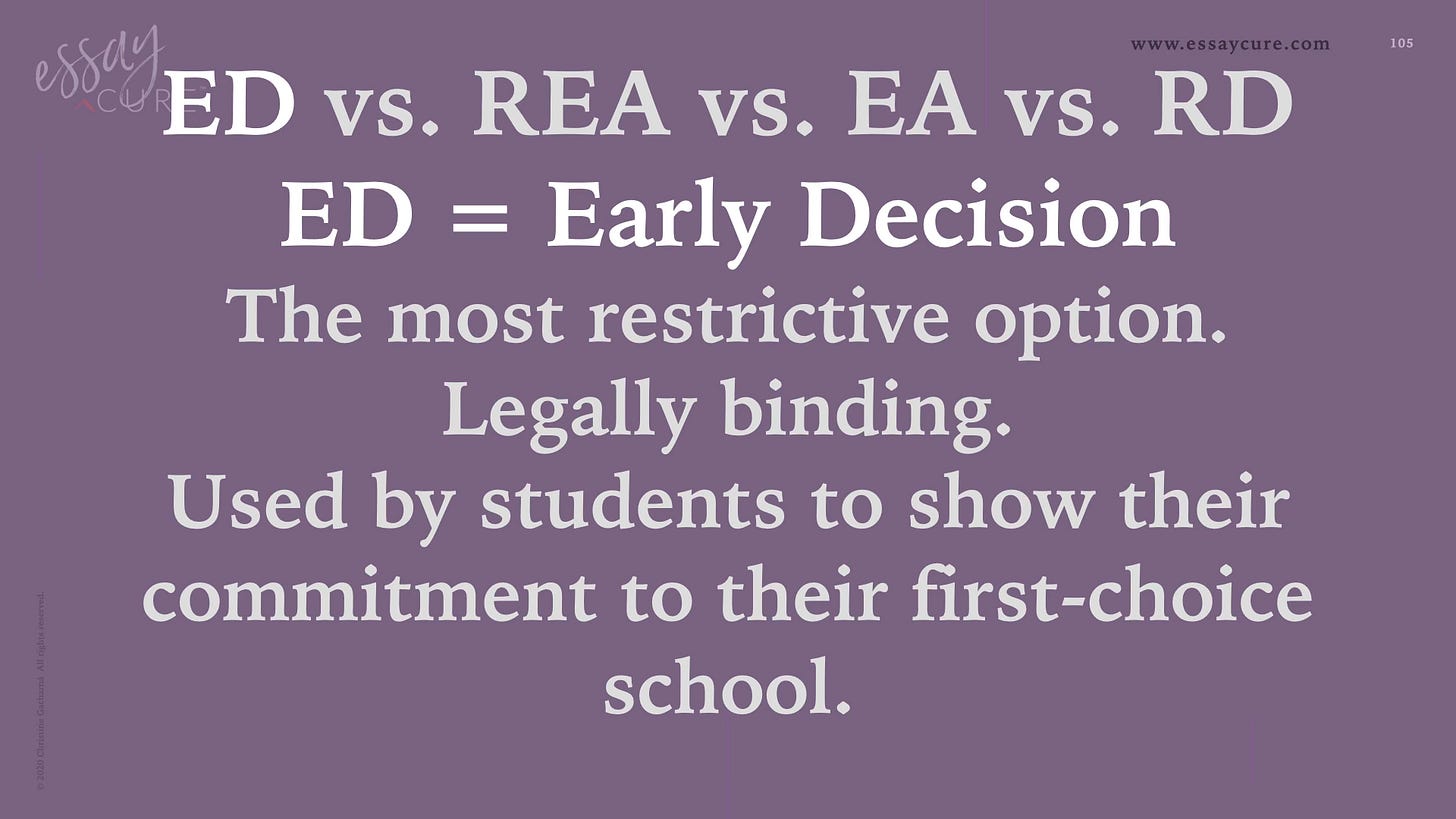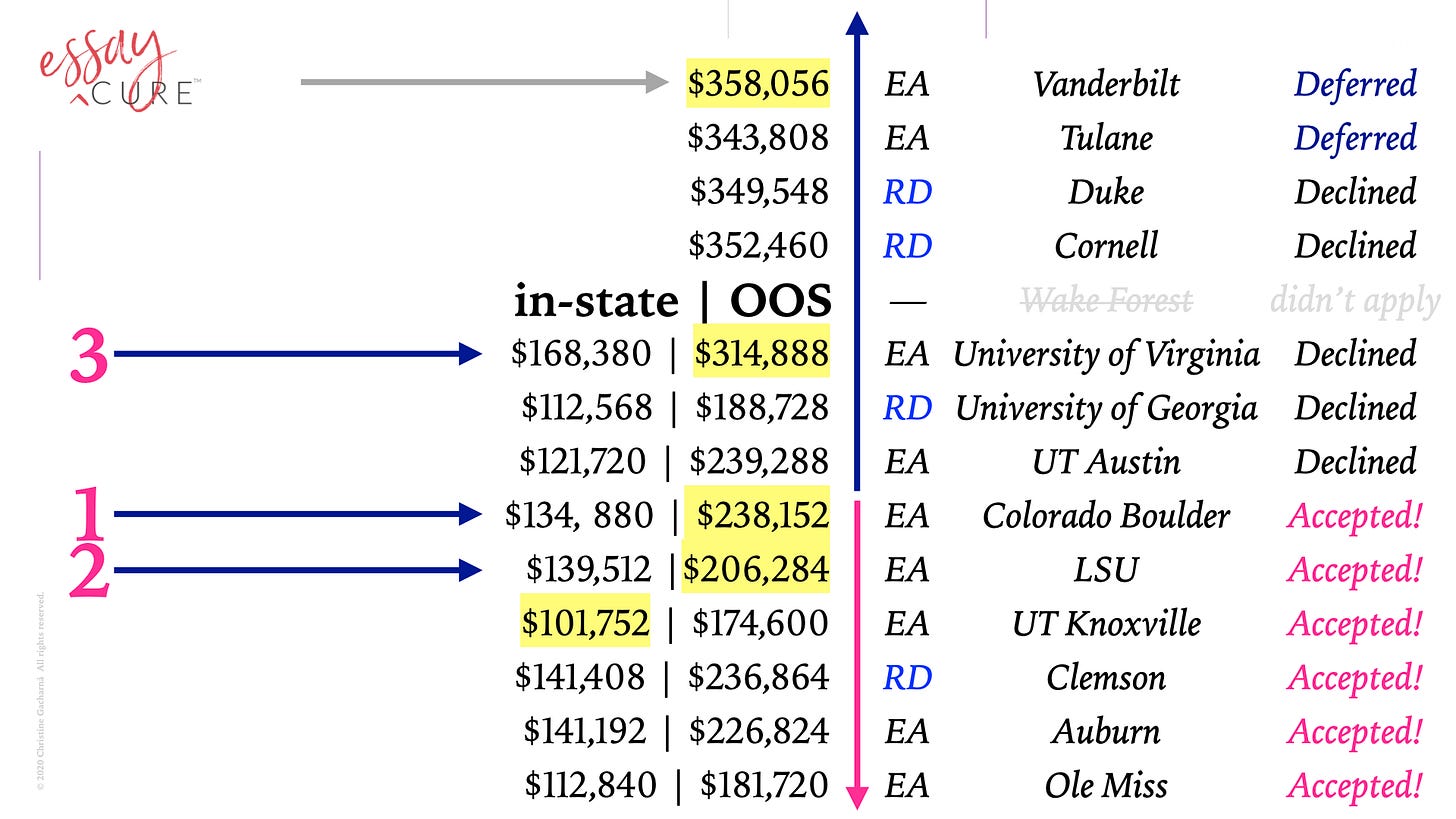Early Decision (ED) versus Restrictive Early Action (REA) versus Early Action (EA) versus Regular Decision (RD): what do these mean, and which one should I use?
Early Decision is the most restrictive option and it’s legally binding.
This is what students use if they’re absolutely committed to a school, they know this is where they want to go, and they're okay with paying the sticker price.
Early Decision comes in two versions: Early Decision 1 and Early Decision 2.
The difference between the two is deadlines and decisions; the application deadlines for ED1 is typically in November wheas the application deadline for ED2 is in January. ED1 decisions are released in December and ED2 decisions are released in February.
Like ED, both ED1 and ED2 are legally binding. If the student is admitted, they must immediately withdraw all their other applications to all other schools.
Not all schools offer Early Decision, or they may offer ED 1, but not ED 2. Every school is different, so students must look at each school to figure out what be the best application strategy considering academic interests and the schools on their list. Students who are denied in Early Decision rounds are done applying to that school and can’t reapply under any other option.
Students who are deferred from ED are released from the binding commitment. These students will then be considered with Regular Decision applicants.
The benefit to not using a binding application option is that students can sit back and wait for all of their scholarship offers to come through from all the schools where they applied. Then they can carefully consider each option, weighing them against one another. But if a student chooses an Early Decision option, what that student is telling that school is, “I’m committed to attending your school, even if you don’t offer me any scholarship incentive.”
Let’s see what this might look like by reviewing these options from one of my students. If this student had applied Early Decision to Vanderbilt, which was her first choice when we started the process, she would have been agreeing to purchase her undergraduate degree for ~$358,000 in total cost of attendance.
That's a very expensive sweatshirt straight off the rack, right?
But as she started touring schools and doing more research, her first choice school changed to University of Colorado Boulder — only Boulder didn’t give applicants the option of Early Decision when she applied. She couldn't play an early decision card at her first choice school, but if she had, she would have been on the hook for >$200,000+ for cost of attendance.
Since she didn’t apply Early Decision or Restrictive Early Action, she was free to weigh all of her scholarship offers from the schools that extended her offers of admission, ultimately accepting a very generous scholarship offer from her second choice school, LSU.
Not every school offers Restrictive Early Action, but it’s the next most restrictive option. “Restrictive Early Action” (REA) is a non-binding college application option where a student applies early to only one specific institution, signifying a strong interest in that school while still being able to compare offers from other colleges during the regular decision process. The “restriction” is that a student cannot apply early to any other private colleges under early action or early decision plans; essentially, it allows students to show a high level of interest in one school without committing to it immediately. Read the fine print, because REA will often allow students to apply early to their public state school.
REA is used by students who want to apply early, but they also want to retain some flexibility.
Early Action (EA) is a more flexible option. It’s non-binding. It allows students to apply early to a lot of schools, but without committing to any one of them. EA application deadlines are usually earlier than Regular Decision deadlines.
Regular Decision (RD) is non-binding. It's a flexible option. It's the standard application deadline. It's used by students who need more time or students who didn't get admitted in the early round to some of their first choice schools.
Q: Which one is best?
A: It depends.
It depends on the student, academic interests, family finances and situations, state of residency, the list of schools the student intends to apply to, and how important a decision timeline is for the student and/or family.
It’s important for students to understand that there is not just one college or university where they can be successful and thrive.
Something to consider: ~one-third to one-half of freshman classes are built in the early rounds. Students who apply early tend to have higher admission rates — but they also tend to be more qualified and more prepared candidates.
Bottom line: applying early to any school, regardless of the specific type of early admissions, gives prospective students a greater chance of both acceptance and merit incentives.
















